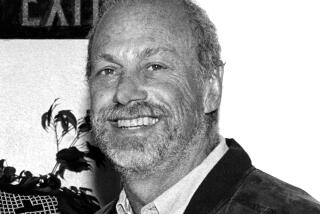Champion of the obscure
- Share via
Outside Santa Monica’s dot-com circuit, the name Richard Rosenblatt doesn’t mean much. He’s one of those guys who buys and sells empty websites. Some industry insiders also know him as the accused spyware baron who sold MySpace to News Corp.
But the excitable 39-year-old USC law school graduate has a plan for the future of Internet media, and $355 million from private investors says he can pull it off.
With blinding speed and little notice, Rosenblatt’s 2-year-old Demand Media Inc. has become one of the largest buyers of articles and video clips for the Web. It expects revenue of nearly $200 million this year and, more surprisingly, a healthy profit.
“This is fascinating,” said Michael McGuire, a Gartner analyst who has followed Web media companies for eight years. “Is this a potential out-of-nowhere media titan? This would seem to be, yeah.”
Demand Media is the kind of company that, if headquartered in Silicon Valley, would generate major buzz. Based instead a few blocks from Santa Monica Pier, it’s been largely ignored.
Yet Rosenblatt, Demand Media’s chief executive, has quietly amassed a network of thousands of websites such as EHow, Expert Village and a slew of special-interest sites including GolfLink, Trails.com and Daily Puppy. The most recent: LiveStrong.com, a health site developed with cyclist and recent Demand Media investor Lance Armstrong.
Although none are huge hits, together they rank among the Internet’s 50 most visited Web networks, according to rating service ComScore Inc. Demand is doing so well that some Yahoo executives have expressed interest in buying it; Rosenblatt said the company isn’t for sale.
Unsatisfied with its current library of 100,000 online videos and more than 250,000 articles, the company is adding thousands more daily from freelancers and pumping them across the network.
Demand Media combines the draw of specialized, semiprofessional content with the well-documented “stickiness” of social networking sites -- the tendency of people to hang around when there is a community of like-minded individuals. Low-cost tools that enable users to comment, rank stories and find other users help keep them there.
At a more basic level, the 470-employee company is mastering the new Google economy. In the same way that EBay Inc. turned homebound merchants into millionaire “power sellers,” Google can assemble niche audiences and bring them to previously undiscoverable destinations, which the search kingpin’s advertising programs then can make profitable.
Drilling down
The more obscure the subject, the more likely that one of Demand Media’s websites appears on the first page of Google search results.
“Google finds the Long Tail,” Rosenblatt said, referring to the Web industry term for less-popular content, “and we fill it.”
MySpace and its younger rival Facebook Inc. are general-interest social networking sites, each with more than 100 million users across the globe. But Demand Media drills down into narrower interest groups, which can make the audiences much more valuable to advertisers.
“MySpace and the others need behavioral advertising and hyper-targeting to figure out why their users are on the site,” Rosenblatt said. “If you’re a golf club manufacturer, why go through that? There’s no mystery why someone is at GolfLink.”
Rosenblatt’s first Internet venture also was designed to help small businesses attract more customers. In 1994 he co-founded IMall Inc., which created electronic storefronts. He sold it five years later to Excite at Home for more than $565 million in stock, much of which disappeared in the bust.
Then came a stab at investing. He bought and sold a domain-name company, which taught him how Google could bring money to unloved corners of the Web, and he put together a group that took control of DrKoop.com for $27 million in 2000, after that stock had cratered. Rosenblatt became CEO, but the company liquidated the following year, giving him that much more respect for the bottom line.
Rosenblatt joined Intermix Media Inc., a mishmash of entertainment and market websites, as CEO in 2004. He gets credit from fellow executives there for encouraging the development of MySpace, the social networking site that dethroned Friendster four years ago and is still No. 1 in U.S. visitors.
At Intermix, Rosenblatt learned about building a mass audience and the power of social media. He also got another chunk of serious money: his $23-million share of the $580-million News Corp. paid for the company in 2005.
By the time he started meeting potential investors in Demand Media, Rosenblatt had an extraordinary record in the hottest sector of the Web. But he was almost too slick, said Fred Harman, a managing partner with Oak Investment Partners.
“Virtually everyone has the first impression of him as a smooth, fast-talking entrepreneur, and you’re just not sure in that initial meeting whether it’s all show and no go,” Harman said. “But it doesn’t take long to figure out he’s a brilliant thinker and a company builder.”
Legal tests
Others might have been leery of Rosenblatt’s brushes with controversy. The Federal Trade Commission sued IMall and two other founders -- but not Rosenblatt -- in 1999, accusing them of misleading customers with unrealistic tales about the money they could earn selling ads on their Web pages.
In 2005, then-New York Atty. Gen. Eliot Spitzer sued Intermix, alleging that it conned millions of consumers into installing ad-spewing spyware on their computers.
Both of those cases settled for millions of dollars without admissions of guilt. Still pending is a suit brought by Intermix investors who say Rosenblatt and other directors sold the Los Angeles company to News Corp. too cheaply because of sweetheart deals that included accelerated stock-option vesting and indemnification for any alleged misdeeds. Rosenblatt said he was proud of the price he won for a company with a 2004 market value of $70 million.
Harman thought of such experiences as good training for Rosenblatt. Oak Investment Partners invested in 2006, as did Spectrum Equity Investors. Goldman, Sachs & Co. joined them in 2007. Their stakes value the company at $1 billion, and they hope to sell stock to the public next year.
Unlike such visionary entrepreneurs as Google Inc.’s founders, Harman said, Rosenblatt’s strength isn’t a devotion to a single idea or invention. Instead, he’s like a mountaineer who keeps in mind the endgame -- creating a next-generation media power -- while constantly reevaluating how to traverse the next 100 feet.
There have been occasional duds, such as the plan to resell domain names ending in .tv along with video and social networking tools. Not every website, it turns out, aspires to be a new-media business.
But other elements of the plan are coming together, aided by this year’s $75-million acquisition of Pluck. The Texas company adds blogs and social networking tools to media sites as diverse as USA Today and the Economist. Simply by allowing reader comments and other interaction, such sites have seen their numbers of page views soar.
Fertile corner
It turns out that social networking also works in unlikely places. Scotts Co., the maker of lawn fertilizer, was getting 50,000 visitors a month in January before Pluck went to work letting people post pictures of their lawns, ask questions and give advice on weed fighting. In April, Scotts’ site got 450,000 visitors, according to Compete Inc.
For now, the big idea at Demand Media is to combine such social functionality with “directed” content -- professionally edited offerings from people who don’t need a lot of money and who can follow very specific guidance.
To figure out which corners of the Web are worth targeting, the company uses a genuine secret formula. The most important of the 50 variables reflect what people are searching for on the Web, the topics that interest advertisers and which subjects in the overlap aren’t already dominated by major brands.
The result is often pretty arcane: how to buy stained glass or how to care for your lizard. Nonetheless, Demand Media shoots out the prospective title to a growing number of pre-screened contributors and gets them working on videos or articles that address those subjects.
The authors are usually people like Willi Galloway, a 27-year-old Seattle gardening magazine editor who spends three hours a week crafting EHow articles. The pay isn’t much, but the exposure promotes her own site, digginfood.
A few actually make a living working for Demand Media. Patrick Eaves, 31, of San Luis Obispo was a paragliding instructor when he answered a Craigslist ad for video producers. Now he can earn more than $5,000 a month churning out hundreds of short instructional clips on yoga, surfing and pretty much anything else having an expert willing to talk on camera free.
Expert Village, bought for roughly $20 million, has funneled more than 76,000 videos to YouTube, where they’ve been played more than 100 million times, with ad revenue there split between YouTube parent Google and Demand Media. The business catering to general-interest and niche media sites is “very high-margin and growing very rapidly,” said Charles Hilliard, Demand Media’s president and chief financial officer.
But Rosenblatt, naturally, is far from done. He said he wants to syndicate material to other people’s sites the way he does within Demand Media’s network.
“My wife has owned SmarterBaby.com for 10 years, and she hasn’t been able to do anything with it,” Rosenblatt said. “This way she’ll be able to buy 100 articles from experts and add in social media.”
Mrs. Rosenblatt, he noted, isn’t the only one who will benefit.
“If we’re worth $1 billion now,” Rosenblatt said, “this is how we get to $10 billion.”
--
--
(BEGIN TEXT OF INFOBOX)
Demand Media Inc.
Headquarters: Santa Monica
Founded: 2006
Employees: 470
Businesses: Internet domain names and related services, such as selling ads on empty sites; providing articles and social networking tools to major media websites; operating its own network of websites with free content from users and professional material from freelancers
Websites owned: Thousands, including EHow, Expert Village, GolfLink, Trails.com, Daily Puppy and LiveStrong.com
Top executives: Richard Rosenblatt, co-founder and CEO; Shawn Colo, co-founder and head of mergers and acquisitions; Charles Hilliard, president and chief financial officer
Projected 2008 revenue:
$200 million
Funding: $355 million from investors including Oak Investment Partners, Spectrum Equity Investors and Goldman, Sachs & Co.
--
Sources: Times research, Demand Media






